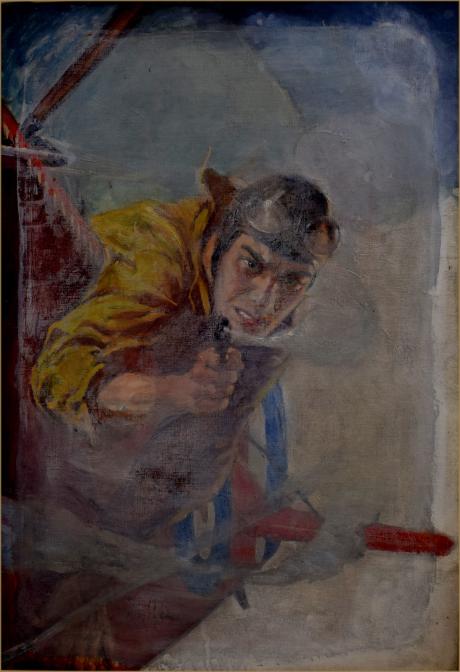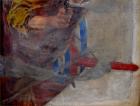signed
Originally, enemy reconnaissance planes that encountered each other in Word War I, would sarcastically wave and smile back and forth, lacking any real way to engage in combat. There are reports of planes ramming into one another in an attempt to bring each other down, but this generally resulted in both planes crashing. Not very efficient.
Soon they started bringing grenades and other munitions to throw, or used their own pistols or rifles to attack enemy planes. These tactics proved to be extremely inaccurate and were rendered useless when the first machine gun was developed that could shoot synchronized through the propeller. This invention is widely credited with creating the basis for modern dog fighting.
Pulp magazines, the popular, inexpensive fiction publications that were read and enjoyed by millions, reached their zenith in the 1930s, though the genre began in earnest in 1896 with The Argosy, a monthly magazine that was printed on low-cost pulp paper. Not a solely American institution, pulp magazines were preceded by the weekly issues of “penny dreadfuls” that were popular in England from the 1830s to the 1890s, so named because of the low price and subject matter of crime and horror. Industrialization and improvements in printing allowed the increasingly literate working class affordable reading material. Part of the popularity of the penny dreadfuls can be attributed to the affordability of the magazines. Because they were printed on cheap pulp paper, they were much less expensive than the high quality, serialized novels of authors like Sir Arthur Conan Doyle and Charles Dickens.
Similar in style to the penny dreadfuls, dime novels became popular in America beginning in the 1860s. The pocket-sized paperback books included reprints of previously published stories in a small format. Eventually, the dime novels featured more newly-authored pieces as sales of the publications grew. The first pulp magazine, The Argosy, was published in October 1896, though the magazine had been published as a children’s weekly since 1882. The first monthly issue of The Argosy was printed on cheap wood pulp paper, was aimed at an adult audience, included purely fictional content, and only cost ten cents. The margin of profit was large enough that the magazine could include much more content that similar periodicals. According to historian Robert Sampson, the magazine’s circulation increased from 9,000 copies in 1894, to 80,000 following its format change in 1896 to nearly 500,000 in 1907 (Yesterday's Faces: Dangerous Horizons, p.11). Other publishers took note of The Argosy’s success, and additional pulp magazines soon appeared on newsstands. The Popular Magazine debuted in 1903 and often featured cover art by famed illustrator N.C. Wyeth. The All-Story Magazine and Blue Book launched in 1905. Other notable pulp magazines being published were Adventure in 1910, Black Mask in 1920, Love Story in 1921, Weird Tales in 1923, and Amazing Stories in 1926.
Pulp magazines were so named because of the inexpensive paper the stories were printed on, in contrast to the more respectable “glossies” such as Collier’s, Life, and The Saturday Evening Post. Presented on newsstands alongside scores of glossies, pulp magazines were able to catch the eye of passersby with their colorful, action-packed, scintillating, and often lurid cover art. To make the pulp magazines more visible, the covers featured artwork by some of today’s most regarded illustrators, including J.C. Leyendecker, Dean Cornwell, N.C. Wyeth, Everett Raymond Kinstler, Tom Lovell, and Frank Schoonover.
Though some pulp magazines provided a mix of stories each month, many catered to certain themes, such as Adventure, Crime, Horror, Romance, Science-Fiction, Sex, Sports, War, and Western.
You could explore adventure on the sea, in the jungle, or in Asia with magazines such as Adventure, Blue Book, The Mysterious Wu Fang, Doc Savage, and Jungle Stories. For stories on crime, spies, or heroes, you could purchase Detective Story Magazine, Dime Detective Magazine, The Black Mask, Spy Stories, Strange Detective Mysteries, or The Shadow. If horror was your interest, you could purchase Weird Tales, Terror Tales, Dime Mystery Magazine, and Horror Stories. Romance magazines catered to women and included titles like Love Story Magazine, Rangeland Romances, Romance, and New Love. Science-Fiction (or Fantasy, as it was called then) could be found in books like Amazing Stories, Wonder Stories, Weird Tales, Captain Future, and Fantastic Adventures. (In Amazing Stories, No. 1, April 1926, editor Hugo Gernsback referred to the genre as “Scientifiction.” Forrest Ackerman, the creator of the Famous Monsters of Filmland magazine, coined the more popular term “Science Fiction” in 1954.) If feminine seduction was more your style, you could find it in the pages of Spicy Mystery Stories, Saucy, New York Nights, and Cupid’s Capers. Sports stories were published under titles such as Fight Stories, Sport Story Magazine, and Baseball Stories. War fiction was created for magazines like Sky Raiders, Submarine Stories, Daredevil Aces, G-8 and his Battle Aces, and War Stories. Finally, stories of the Old West could be found in the pages of Western Story Magazine, Cowboy Stories, Dime Western Magazine, and Wild West Weekly.
However sensational the images on the cover, the magazines included fiction written by many respected authors such as Edgar Rice Burroughs, Ray Bradbury, Zane Grey, H.P. Lovecraft, H.G. Wells, Horatio Alger, Jack London, Upton Sinclair, Raymond Chandler, and Arthur C. Clarke. Furthermore, many famous characters and stories were first published in pulp magazines. Edgar Rice Burroughs’ character John Carter first appeared in February 1912 in the pages of The All-Story and his creation Tarzan debuted in All-Story Magazine in October 1912. H.P. Lovecraft’s legendary Cthulhu monster mythos made its debut in the February 1928 issue of Weird Tales. The character Zorro first appeared in All-Story Weekly in August 1919, and Conan the Barbarian debuted in Weird Tales, December 1932.
The popularity of pulp magazines crossed over to other media. Hero adventures were easily translated to the Silver Screen in serials like Buck Rogers (1939) and Flash Gordon (1936), feature films Tarzan of the Apes (1918) and The Mark of Zorro (1920), and radio dramas like The Shadow (1937). Pulp magazines have even made appearances in major motion pictures. In the 1943 Alfred Hitchcock film Shadow of a Doubt, actor Hume Cronyn’s character obsesses over the exploits in such pulp magazines as Unsolved Crime Stories, Detective Stories, and Murder Mysteries, which helps lead to the capture of a killer on the loose. Also, in Back to the Future (1985), the character George McFly is seen holding the Fall 1954 issue of Fantastic Story when his son, Marty, startles him awake to proclaim he is Darth Vader from the planet Vulcan. Finally, Hollywood continues to revive pulp characters in films like Conan the Barbarian (1982), The Shadow (1994), and John Carter (2012).
Although pulp magazines survived two World Wars and The Great Depression, they faced a steady decline in readership throughout the late 1940s and 1950s. Paper drives during World War II limited the availability of stock for publication, superhero comics had captured the country’s attention with the debut of Superman in 1938, and readers began buying up new small mass-market paperback books branded as Pocket Books starting in 1939. The explosion in popularity of television throughout the 1950s signaled the end for the few surviving pulp magazines.
Sidney H. Riesenberg (1885–1971) was an illustrator and artist who lived in Yonkers, NY and commuted to his studio in NYC by train. He is known, as a professional illustrator, for his posters for the United States Marine Corps and the Liberty bond programs, for his illustrations for book covers, magazines, and for oil paintings of diverse subjects. He retired from his professional work and dedicated his full-time energy to painting fine arts and teaching. He began, in 1937, spending summers in Rockport, MA, where he painted scenes of the small fishing town. He was active in the Rockport Art Association, teaching oil painting and participating in water color figure painting classes.
Riesenberg was born in 1885 in Chicago. He was educated at the School of the Art Institute of Chicago, where he was recognized for his compositions in oil. He moved to Yonkers in 1905 where he began his career as a professional illustrator, after a sojourn in the American west pursuing what became a lifelong interest in depicting the frontier west as was being popularized then by Zane Grey and other writers. In the early 1930s, he began doing illustration work for magazines. In the 1930s and 1940s, his work was often featured at venues such as the National Academy of Design and in organizations such as the Allied Artists of America. In the 1950s he was an art instructor at the Westchester Workshop in White Plains, NY. [5]Riesenberg was also the vice president of the Yonkers Art Association. Riensenberg died in 1971 in Cambridge, Massachusetts.
Riesenberg had a brother six years older, Felix, with whom he was extremely close. They shared a love of creating art and adventure. In their youth, both wrote short stories in journals they kept.


Of Riesenberg's work, his contributions during World War I are well known and he is described as "one of the greatest illustrators of the World War I era." Riensenberg's style, it has been said, shows influences from Impressionism.
He produced many posters for the Marines in addition to posters advertising the Liberty Loan campaign during World War I. One of Riesenberg's most well known works is his 1918 World War I-era poster, Over the Top for You, which illustrates a young doughboy clutching the American flag. With its bold illustration and concise text, like many war posters of the time, Over the Top for You encouraged the public to support its military by purchasing liberty loans.[10] Among other posters, it was selected to display in the Smithsonian American Art Museum under the exhibit, Over the Top: American Posters from World War I. Riesenberg also created several posters for the United States Navy, one of which, titled Democracy's Vanguard, illustrates Marines landing from a boat to initiate an offensive. Another illustrated uniformed soldiers raising the flag against the background of a warship.
Riesenberg created illustrations, including covers, for many publications such as Boys' Life Magazine, the official monthly magazine of the Boy Scouts of America, Harper's and The Saturday Evening Post. His many thematic subjects included scenes from places he lived, historical and action scenes, portraits, as well as depicting the Old West.



